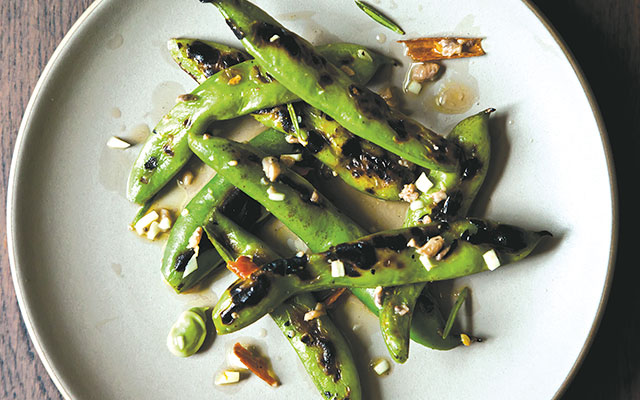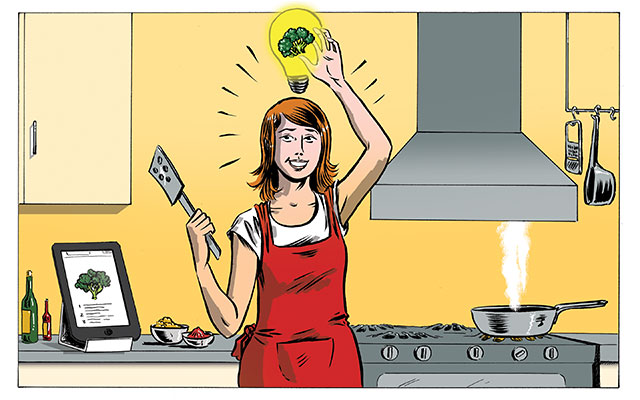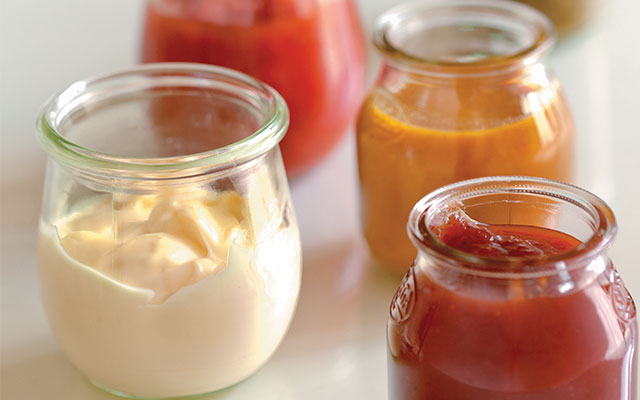When I first heard about Kristen Miglore’s book, Food52 Genius Recipes: 100 Recipes That Will Change the Way You Cook, something in me recoiled. Enough with the celebrities, the super-expensive blenders, the super-perfect kitchens, I thought. If I have to be Einstein to get dinner on the table, I’m out. I’ll just go with the dumb people and eat kibble in the dark. It won’t be a great life, but at least I won’t need to grasp string theory at the end of a long day at the office.
After I read the book, though, I realized it wasn’t a genuflection at the altar of the fancy, inaccessible, and unachievable, but a sort of MacGyver collection of culinary problem-solving — the problem being how to cook real food more easily, and with a little flair. These are some of Miglore’s more inspiring solutions:
- Making scrambled eggs in hot, salty poaching water, so there’s no crusty pan to clean
- Cooking broccoli in oil until it turns into a sort of sauce that’s perfect for serving on top of toasted bread or some cooked grain
- Preparing guacamole by simply folding together squares of avocado and a paste ground from onions, salt, jalapeño, and cilantro
- Cooking beets with their greens in a single pan
These are the sorts of recipes that make life easier, which, in my current thinking, is exactly what recipes need to do. Because life is hard, and I don’t need arugula making it harder.
Genius Recipes, it turns out, is a greatest-hits compilation from Miglore’s column on Food52.com.
She gets the recipe ideas from readers and tests them in her tiny New York City apartment, where there’s no fancy equipment or a staff of dishwashers and prep chefs.
If she likes a recipe, and it works, she tests it with her colleagues in the Food52 kitchens to get additional feedback. If, after all this, she decides the recipe makes life easier, radically simplifies a technique, solves a problem, or provokes another sort of Eureka! moment, it’s a Genius Recipe.
“A lot of times, I start with something very basic, just someone’s email saying, ‘You have to try this. It’s genius, it’s killer, it’s going to amaze you.’ Just with that, you feel like you’re doing something with a friend,” Miglore told me. “It makes cooking less lonely — the whole book, essentially every recipe, starts with that whisper in your ear.
“Then a lot of times you’re thinking, ‘I don’t think this has the slightest chance of working,’” she adds. Case in point: a recipe for chicken from Chef Michael Ruhlman, who starts a brine with sautéed onions. “You have to sweat a whole bunch of onions in a single teaspoon of oil over medium-high heat,” says Miglore.
“There’s not enough oil; you think the onions will burn; none of it makes any sense. But, you’re using a ton of salt because it’s the base to a brine, and the salt pulls out the moisture, making the onions collapse in their own liquid right away. But the biggest surprise is that it makes the best chicken.”
I tried Miglore’s Genius Recipe for fava beans, and I was sold. I had no idea that young fava bean pods are edible if you sear them — how did I not know this?
Then it occurred to me: We are all standing on the shoulders of the genius cooks who came before us. Someone a few thousand years ago tried grinding mustard seeds in vinegar and water. He or she told two friends, and they told two friends, and the result now shows up on more ballpark franks than you can count.
Someone else figured out that peanuts could be roasted, salted, and ground into peanut butter. A brilliant invention.
In fact, most of what we eat today must have been someone’s stroke of genius. Jonathan Swift famously wrote, “He was a bold man that first ate an oyster.” But the person who ate the first shrimp, and the one who made the first shrimp cocktail must have been pretty bold — and smart, too. Maybe not Einstein, but not a slacker either.
“For me, genius can be better home cooking, smarter home cooking, even braver home cooking,” Miglore says. “When you see someone else do a crazy thing and it turns out, it makes it OK to do it yourself.”
So let’s hear it for all the nameless geniuses who invented omelets and barbecue and tacos and everything good. And let’s celebrate our own genius when we get something on the table smarter, faster, and better.
After all, genius ideas don’t only originate from the rich and famous; they’re handed down to us in jars of mustard, just waiting to be spread around.
Fret-Free Favas

Scared or simply annoyed by fresh fava beans, which seem to require cracking open pod after pod before cooking? Don’t be, writes Kristen Miglore in Food52 Genius Recipes: 100 Recipes That Will Change the Way You Cook.
“Favas don’t deserve their high-maintenance reputation. The fact is, they were born edible, from pod to peel to bean. You just have to know what to do with them. To eat the whole fava (and not waste a thing), do as Chef Ignacio Mattos does and throw them on the grill. Smoke and char do great things for favas’ thick-walled pods and skins, and they’ll soften enough that you can eat them with your hands.”
Ignacio Mattos’s Grilled Favas
Serves 4 to 6
- 1 lb. fresh fava beans in their pods (the younger, the better)
- 1 tsp. fleur de sel (salt), plus more as needed
- 1 tsp. ground chili
- 1 tsp. fresh rosemary leaves
- 3 to 4 cloves garlic, chopped
- ¼ cup extra-virgin olive oil, plus more to finish
- 2 tbs. water
- 1 lemon
- 7 to 8 anchovies canned in oil, finely chopped
- 1 handful toasted bread crumbs (optional)
1) Prepare a medium-hot fire in a gas or charcoal grill.
2) Mix together the fava beans, fleur de sel, ground chili, rosemary, garlic, olive oil, and -water in a large bowl. Toss to coat the fava pods, then place them on the grill over medium-high heat. Grill the favas for several minutes, until charred, then flip them over and char the other side, cooking until the pods seem about to open.
3) Remove the pods from the grill, return them to the mixing bowl, and squeeze the lemon over them. Toss the pods to coat. Add the anchovies to the bowl, mixing well. Check the seasoning; add salt, if necessary.
4) Place the pods on a serving platter, drizzle to taste with olive oil, and sprinkle the bread crumbs on top. Serve hot or at room temperature; eat with your hands.
Reprinted with permission from Food52 Genius Recipes by Kristen Miglore, copyright © 2015. Recipe courtesy of Ignacio Mattos. Published by Ten Speed Press, an imprint of Penguin Random House LLC.



This Post Has 0 Comments